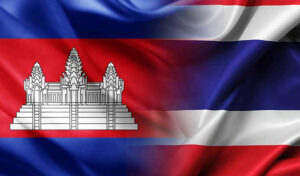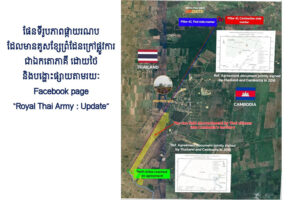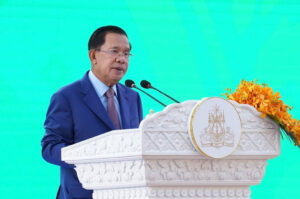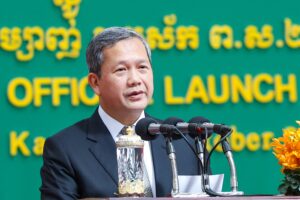Selected Comments of Samdech Thipadei Hun Manet, at the certificates awarding ceremony for legal students and lawyers [Unofficial Translation]
[1]
(1) National Authority for Dispute Resolution outside the Judiciary plays an additional and complementary role to facilitate and increase the efficiency of resolving disputes
[…] In this term, we have assigned some tasks for the Royal Government’s lawyers […] to help solve issues with challenges such as real estate fraud […] and representing the victims. In addition to (the RGC’s lawyers), we have this lawyers’ team of Samdech Techo, who play an important role in helping victims, especially the poor. I have set up my own team of lawyers too to help resolve disputes, and provide legal assistance to the people […] to ensure harmonization (in society) […]
Promoting settlements of congested (legal cases) in the judiciary is important because sometimes our courts have a resources and staff than the number of cases. On this note, cases that are left unsettled for a long time led to people’s feeling that it is an injustice (because the court seemed to have) ignored them. I have found that there have been so many cases that the out-of-court settlement has helped a lot indeed […] the organization of the National Authority for Dispute Resolution outside the Judiciary has played an additional and complementary role to facilitate and increase the efficiency of resolving disputes for the people […]
(2) Application of the law by certain individuals or groups must not infringe upon the rights of others or society
On August 18, (2024), there were two (events) – one was the Hungry Ghost Festival and the other was the “August 18 plan” which (the opposition) plotted an attempt, disguising under the right to freedom of expression, to turn it into something else. Therefore, the application of the law is important not only to help the citizen to exercise and protect his rights, but also to limit the law enforcement of some individuals or groups not to infringe upon the rights of others an/or society. In other words, to prevent (them from having) conflicts, to prevent (them from taking) any actions that can affect the harmonization and cause a rift in society […]
Regarding the concerns on the CLV-DTA (Development Triangle Area), citizens have the right to express their views and concerns about the possible loss of land or the loss of national sovereignty […] the Royal Government has understood their concerns and laid out messages of explanation, as well as taken a series of measures […] what had happened on August 18 then – a small group of people, who may have been extremists, wanted to turn this worrying situation – the origin of most citizens who want to express their concern for the future of the nation – into something out of the ordinary. (This group of people) used the momentum to inspire actions that could have been disastrously burning our country […]
(3) A group of people tried to divert the 18-August demonstration to overthrowing the Royal Government
(For the people,) they have expressed their opinions for the Royal Government to listen to their concerns and to take action to ensure that (missing the four provinces) will not happen. However, stemming from the organization of a demonstration against the CLV, a small group of people took the opportunity, (firstly,) to divert and urge (the demonstration) to act in order to overthrow the government. Asked if this would be beneficial for the people? (They) have stated clearly their purpose is to “defeat the government, not just the removal of (Cambodia) from CLV-DTA.” The biggest instigator was someone who lives in a foreign country, including the individual Hay Vanna in Japan. When we thwarted the incident on August 18, he came out and said, “let us (do it through) the election” […]
The second fact is that they announced that it was a non-violent demonstration, but many of you are aware (that it was not,) because they posted their actions on TikTok. They formed a Telegram group, consisting of people with knives, swords, catapults with iron balls, and there was even the talk of buying drones to drop explosives and/or Molotov bottles on police. Would this be defined as a non-violent demonstration? A non-violent demonstration they would need paper banner to write content to make their cases, not talking about knives, swords, buying drones to drop bombs against the authorities […] and they not only talk on social media […] practically, they have gathered people […] whereas the one who made the loudest noise is abroad and those who followed his call were in (action) in the country […]
Thirdly, that they prepared to take up weapons, knives, bombs, drones, etc. […] was because they have targeted attacks on the authorities, and fire-setting on some main targets. This is recorded from the Telegram system […] We may ask (firstly,) what stand would the authorities take? Would it be our task to prevent it from happening or wait for it to happen before responding […] the Royal Government needs to prevent it from happening. If the image of burning in Phnom Penh occurs, how bad would it affect the socio-economic situation? […] what else should the authorities do, if not enforcing the law? […];
Secondly, to what extent do we soften their approach? We allow freedom of expression but exercising such rights should not affect other people’s […] we have carried out the task righteously and prevented the (chaotic) situation from happening. All this evidence is the implementation of the law to ensure the right of citizens to express themselves, but not to exceed to impact on the rights of society and other citizens […]
(4) Implementing the law, protecting the Constitution and the rights of voters
The Royal Government implements (such measures) to protect the rights of all citizens, to implement laws to protect the Constitution and protect the rights of voters […] we cannot allow the whole country’s elections results be toppled by a handful of people […] one may ask how many people are inciting the burning of the country, causing trouble to the economy, and bringing down the Royal Government? Have those few asked the 8.2 million voters? Or the 17 million people? […]
The implementation of legal measures (to prevent what were supposed to happen) on August 18 was to protect the law, protect the Constitution, protect the legal rights of the voters. The majority of people in the country, and even some came (from abroad), have been the overwhelming majority who expressed their opinions through the elections. It would be appropriate to give their votes a chance, to listen to their aspirations, because they have cast their votes to make their choices already. They have given us (the Royal Government) the five-year term to ensure peace and solve problems […]
(5) Calling for weapons purchase, targets to set fire, and overthrowing the legitimate government are clear facts of illegal activity
The Royal Government have been listening (to the people) on this matter […] whereas by implementing the law to protect the Constitution and the rights of the people, for example, on August 18 […] the number of people arrested was 66, of which the authorities have released 57 after figuring out that they were just followers without knowing the clear cause […] whereas the remaining 9 are the inspiring masterminds whom the competent authority has to build a procedure to go to court […]
There was a human rights organization that condemned the Royal Government (for the) arrest (of some people) […] I have asked them to look at the facts clearly. The charge (on action) before August 18 was the fact there was a rally, a call to buy weapons, to set targets on fire, and to overthrow the government. There is a clear fact that this is already an illegal activity. Why did they not come out at that time and warn them not to do such illegal acts? They stood idle. Some even turn their deaf ears too. Once the (Royal Government) took action, they cry foul that the RGC violates human rights […]
(6) Three groups of people on CLV-DTA
Regarding the origin of the CLV-DTA, there have been interpretations all along. Though the majority of people have understood, some still have concerns […] before issuing each policy, the government has listened to the people through holding a forum. For instance, before issuing the first phase of the pentagonal strategy, we met with the private sector and all sectors, and listened to what they wanted […] as of the present day, the forum does not have to be one where we all sit down. Millions of comments on social media are a public forum where we grasp the concerns of the people […]
As of now, there are three groups of people. The first group expresses concern about the loss of land and loss of sovereignty in the four provinces in the future, distrust in this cooperation, fearing that we would lose out, and suggested withdrawing from the cooperation and embarking on self-development. The second group expresses concern about the loss of sovereignty and territory but believe that we can do so only if we develop the area both by ourselves and in cooperation […]; and the third group is quiet, but also wants to ensure development without losing territory and sovereignty throughout the country, especially in the four northeastern provinces […]
(7) The RGC cannot sit and listen for five years, and do nothing but set a policy to tackle issues head-on
As you could imagine, the Royal Government is different from those who are not in power. We have no right to just sit and listen. We have to formulate policy and act. We cannot get the votes just to sit and listen for five years, and do nothing. We need to figure out what needs a surgery and set a policy to tackle head-on to target […] we need to look at commonalities and differences. There are two commonalities between those who support cooperation and those who do not.
Firstly, whatever we do, we must make sure that we will not lose land and sovereignty in the four provinces in the future. That is the point of commonality for all the three groups. Secondly, the four provinces must be developed making Cambodia strong and they all have this as commonality too. What lacks unity among them is on the one side Cambodia must do it all by itself and the other, Cambodia can do itself and with cooperation. Which one does the Royal Government take?
Are we going to sit down and keeping talking about winning and/or losing, or are we going to look at the big goal that we all want development and ensure that we are not going to lose sovereignty and territory in the future? […]
(8) The common point of all Cambodians is to protect the territory, protect the sovereignty and develop the four northeastern provinces
If we were able to prevent the loss of sovereignty, but the place is left in poor condition and undeveloped, there would be insufficient number of people coming to reside (in the border area), that would not be good thing. If we have a lot of people coming to reside but we cannot implement our laws, and that would take into account the law on immigration, plus investments, which would attract the Cambodians to come live in the four provinces, we would still face a problem […] on August 22, I laid out a number of action plans to respond to the real concerns of the people, in which the common point of all Cambodians is to protect the territory, protect the sovereignty and develop these four provinces for the better […] should we sit still waiting to mediate and find out who loses and who wins, we will lose the major task […]
(9) The abilities maybe different, but the spirit of patriotism is the same
(If building border ring roads has been) in the plan, why is there a need for the people’s contribution to budget? Well, it is for the people to be involved. When I announced this on August 22, and even when I visited the border before then to see the road engineering force with Gen. Kwan Seam […] many have commented in my social media accounts that should I allow the setup of a Fund for the infrastructural development in the border area, as the Cambodians, who worries about the territory, big or small, they would contribute to the efforts […] that is the biggest motivation. So far, we have nearly 400,000 people making contribution to the Fund every day. We are not closed yet […]
So far, the construction of the border ring road, which is more than 2,660 km in total […] has completed 1,300 km or 50%. The remaining length to build is more than 1,300 km […] I have approved, at the end of July 2024, the plan of the Engineering Commander – HE Kwan Seam – to continue to complete the job for the next 10 years (using a) budget of more than 200 million dollars […] together, we build (the border infrastructure) and defend the nation by sympathetic contribution, whether it is 100 Riels or 1 million dollars. The abilities are different, but the spirit of patriotism is the same […]
(10) The Northeast province proclaimed in 2022 the 4th economic pole
People (would) go to (the border area) in two ways. Firstly, when we promote economic development to create more investment jobs. Once we have a lot of works there, they will go […] Samdech Techo has declared since 2022 that the Northeast is the fourth pole for the development of economy, agriculture, industry, and tourism. It is not a new thing. We have been doing this for a long time […] the program to provide land to the people at the border is not something we just did. It has been there for a long time, but we now are increasing this ability to put in place a policy to make it hit where it is needed […]
We should not sit back to argue who wins and who loses out. The big task is to put in place policies to ensure the development, population growth, economic growth and the construction of connectivity infrastructure so that no part of Cambodia would disappear because the people never reach out […] my plan is to build road to reach the dragon’s tail (shape border area) […] so that we can send our people and economic activities there […]
Doing all of this is to listen to the people and solve the concerns of the people on the future, because this CLV-DTA issue is not about the present alone. It is about everyone’s future […] so, in order not to worry about that, we have to scatter – by bringing about developments – more Cambodians throughout the border areas and country as an effective fence to protect sovereignty and strengthen the economy […]
(11) Construction of border fences would cost 1,700 million dollars, while border ring roads costs about 500 million dollars
Some people want us to build a (border) fence and not the border ring roads. There are many methods, but I would choose to build the border ring road and take the people as a (border) fence. The day before, some calculation of building a length of 1,270 kilometers fence, it would cost anywhere at 1,700 million dollars […] while for the total length of border ring road, we will spend more than 500 million dollars. Now that we accomplished half of it, the remaining section will need 200 million dollars. Making a fence is not easy. No country in this world does it all […] the government has to look at something more viable. It cannot stand to judge between who loses and who wins, to withdraw Cambodia out or to keep it in, or to build a fence or a road, while at the end of the day, we will not do anything. That would be a big loss. The biggest loss would be when we cannot control the situation, leaving the country to burn down, the economy to plunge, the country is broiled with infighting, and loss of peace, stability and security […]
[2]
(12) To have a committee to manage and disseminate information transparently to the people about how the contributed fund is being used
Regarding the Fund, more than US$ 19 million has been contributed to the (Border Infrastructure Development Fund). The question is, how do we manage the Fund? To ensure transparency and right-on to objective is an important task. We will set up a management and publicity committee. His Excellency Kwan Seam of the Engineering Command will make a detailed plan to report publicly to the people about the project to be fulfilled. We have 1,300 kilometers left and more than 10 years (time with) more than 200 million budget to accomplish. On this note, the money received from the contributions will go to help build which part of the road, and people can go and see for themselves whether or not they have been used properly […]./.






